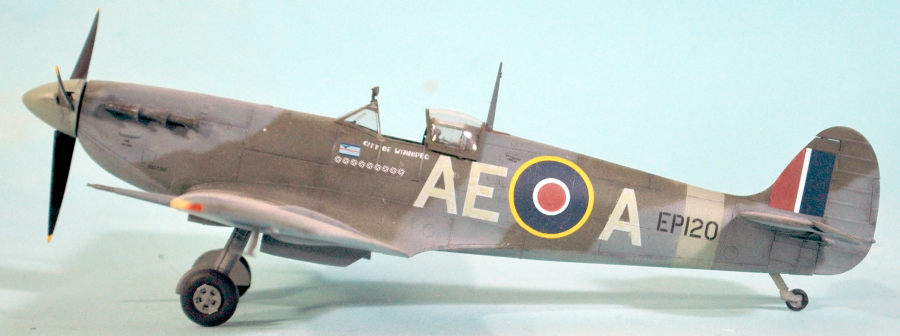
Eduard 1/48 Spitfire Vb
| KIT #: | 82156 |
| PRICE: | $54.00 |
| DECALS: | Six options |
| REVIEWER: | Tom Cleaver |
| NOTES: |

| HISTORY |
With the arrival of the Fw 190 in August 1941 the Spitfire Vb was outclassed in everything but turning radius. As Al Deere said, “Turning doesn’t win battles!” In an effort to counter the Fw-190 threat at lower altitudes, where the Spitfire Vb was competitive many of the Sptifire Vbs had their wingtips “clipped,” reducing wingspan to 32 ft 2 in. This increased both roll rate and airspeed at lower altitude. These “clipped Spits” used the Merlin 45M which had a smaller "cropped" supercharger impeller and boost increased to +18 lb, producing 1,585 hp at 2,750 ft and increasing rate of climb to 4,720 ft/min at 2,000 ft. In this configuration, the Spitfire Vb continued to be used by Fighter Command until all were replaced in frontline units early in 1944.
Spitfire VB EP120
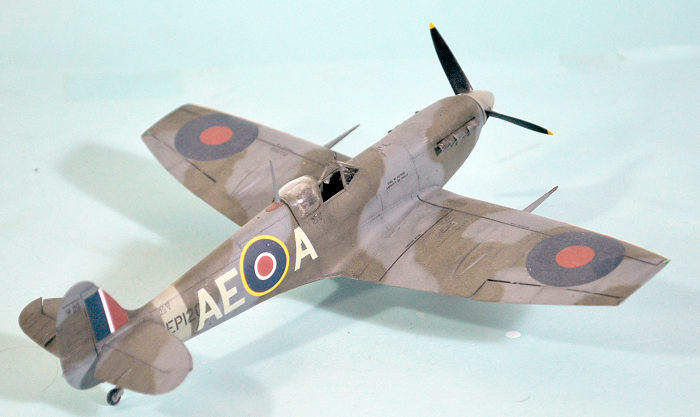 Spitfire
Vb EP120 is probably the most famous Spitfire used by the RCAF still in
existence. Built at Castle Bromwich in 1942, EP120 originally went to 501
Squadron on June 4, 1942, where she flew in support of the Dieppe raid. During
one of these missions, Wing Commander Patrick Gibbs, flying EP120, shot down a
Do217.
Spitfire
Vb EP120 is probably the most famous Spitfire used by the RCAF still in
existence. Built at Castle Bromwich in 1942, EP120 originally went to 501
Squadron on June 4, 1942, where she flew in support of the Dieppe raid. During
one of these missions, Wing Commander Patrick Gibbs, flying EP120, shot down a
Do217.
On September 9, 1942, EP120 was transferred to 19 Squadron, and on April 22, 1943, she was assigned to 402 Squadron RCAF, becoming the personal mount of the Officer Commanding, Manitoba native Squadron Leader Geoffrey Northcott, DSO, DFC and Bar.
Northcott was credited with nine victories total and achieved six of them while flying EP120. The first victory was scored on June 27, 1943, when 402 escorted Beaufighters against a German convoy off the Dutch coast. Northcott achieved this first kill against a Bf 109, earning his first DFC in the process.
Leading the squadron on an escort mission on August 2, Northcott shot down two more Bf 109s, earning a bar to his DFC.
On August 22 while escorting USAAF B-26s, Northcott shot down a Fw 190, shooting down a second on September 4. On October 3, he damaged a Bf 109, and on October 24, shot down a third Fw 190 for EP120’s seventh kill.
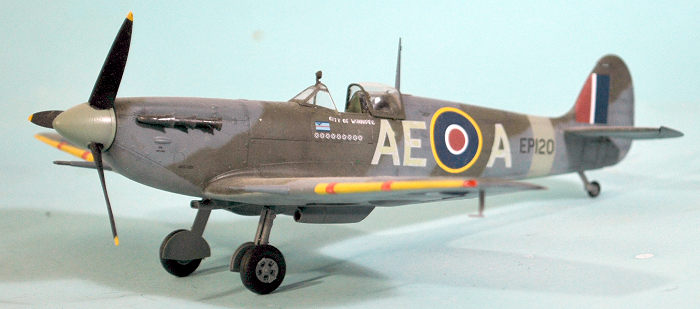 EP120
was damaged on February 12, 1944, and was returned to Castle Bromwich for
repairs that were completed June 8. EP120 then served with various training
units for the rest of the war before being grounded as an instructional airframe
in June 1945. During the 1950s, the Spitfire became a “gate guardian” until 1968
when she was used as a static aircraft in the movie “Battle of Britain.” She
served again as a gate guard until removed in 1988 when plastic “Spitfires” were
created to save the originals, which had fallen victim to the environment over
the years.
EP120
was damaged on February 12, 1944, and was returned to Castle Bromwich for
repairs that were completed June 8. EP120 then served with various training
units for the rest of the war before being grounded as an instructional airframe
in June 1945. During the 1950s, the Spitfire became a “gate guardian” until 1968
when she was used as a static aircraft in the movie “Battle of Britain.” She
served again as a gate guard until removed in 1988 when plastic “Spitfires” were
created to save the originals, which had fallen victim to the environment over
the years.
EP120 was purchased by The Fighter Collection in 1993 and restored by Historic Flying at Audley End. Following restoration, EP120 flew again for the first time on September 12, 1995 and is still flown wearing Northcott’s markings from her 402 Squadron RCAF days. With seven victories credited, EP120 is probably the most successful Second World War aircraft in existence still flying.
| THE KIT |
Eduard Profipack kit 82156 is a 2022 re-release of Edurd’s well-regarded Spitfire Vb (late) kit. The kit includes decals for six interesting markings not “done to death,” including for EP120.
| CONSTRUCTION |
Remember that the kit design is very precise, and ham-handedness will guarantee a less-than-desired result. All sprue nibs need to be trimmed off and the mating surface smoothed, and no paint on those surfaces. Take your time, follow the instructions, and you will get a nice result.
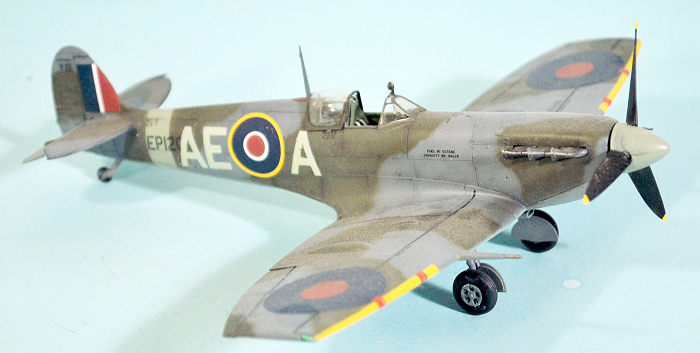 I
deviate from Eduard’s assembly instructions by not completely assembling the
wing separately and then mating it to the assembled fuselage. Rather, I assemble
all the wheel well in the lower wing part, then I attach that to the assembled
fuselage, getting a good tight fit to the fuselage fore and aft of the wing.
Then I attach the upper wing, getting a good tight fit at the wing-fuselage
joint, and then gluing the outer wing to the lower wing part. If you do it this
way, there is no pushing and shoving to get a less-than-optimal fit, and no use
of putty anywhere.
I
deviate from Eduard’s assembly instructions by not completely assembling the
wing separately and then mating it to the assembled fuselage. Rather, I assemble
all the wheel well in the lower wing part, then I attach that to the assembled
fuselage, getting a good tight fit to the fuselage fore and aft of the wing.
Then I attach the upper wing, getting a good tight fit at the wing-fuselage
joint, and then gluing the outer wing to the lower wing part. If you do it this
way, there is no pushing and shoving to get a less-than-optimal fit, and no use
of putty anywhere.
Of note, all Spitfire Vs used the paper laminate seat, which is painted brown, with a black leather back pad.
| COLORS AND MARKINGS |
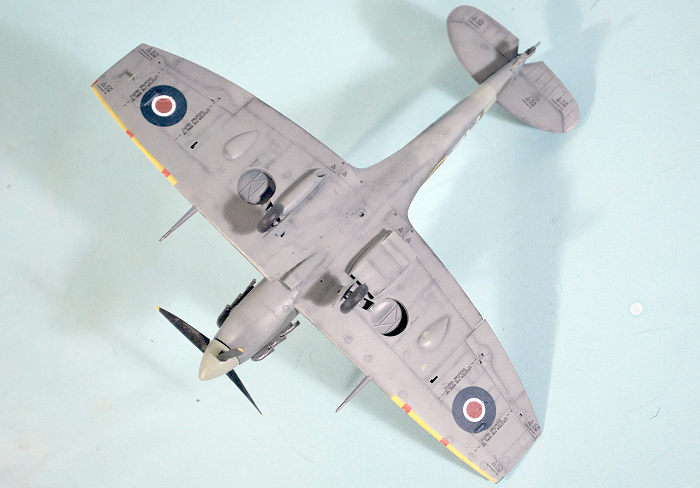 I used
Tamiya’s RAF colors, XF-81 RAF Dark Green, XF-82. RAF Ocean Grey and XF-84, RAF
Sea Grey Medium. The spinner and fuselage band were done with XF-21 “sky”
lightened to the proper shade with white added 1:3 (The OOB color is too dark).
The scheme was applied freehand.
I used
Tamiya’s RAF colors, XF-81 RAF Dark Green, XF-82. RAF Ocean Grey and XF-84, RAF
Sea Grey Medium. The spinner and fuselage band were done with XF-21 “sky”
lightened to the proper shade with white added 1:3 (The OOB color is too dark).
The scheme was applied freehand.
Eduard’s decals were used as standard decals, none of the “peel off” business. They melt down just like every other decal you’ve ever used under a coat of Solvaset, and there’s no chance of wrecking the decal pulling it up in the process of peeling off the clear backing.
I unmasked the canopy and positioned it open, then attached the landing gear, exhausts and prop and called it done.
| CONCLUSIONS |
Eduard’s Spitfires are the best kits of this famous airplane available in 1/48 scale. The kit design is superb and if you follow the instructions (adding in my little trick about assembling the wing) you are guaranteed of a good model that will look great with paint and decals applied. Recommended for any experienced modeler.
17 November 2022
Copyright ModelingMadness.com. All rights reserved. No reproduction in part or in whole without express permission.
Review kit courtesy of Eduard.
If you would like your product reviewed fairly and fairly quickly, please contact the editor or see other details in the Note to Contributors.